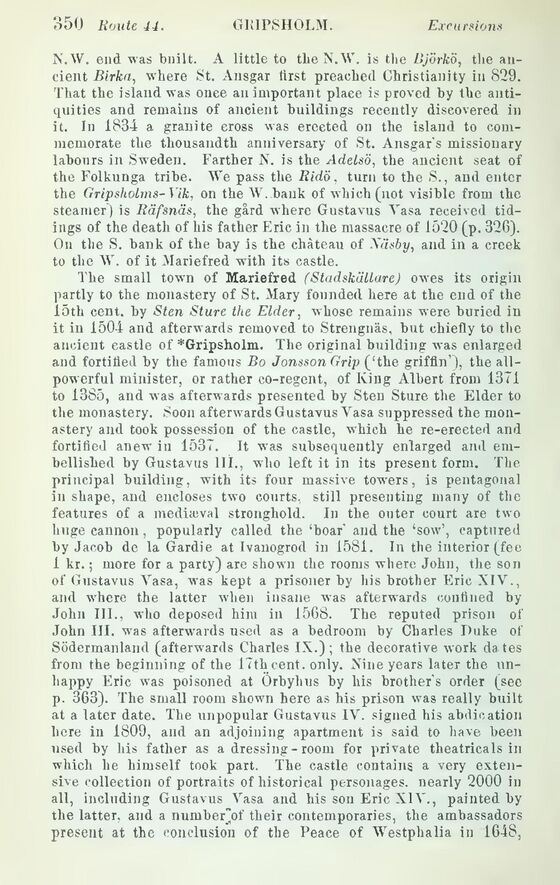
Full resolution (JPEG) - On this page / på denna sida - Sweden - Pages ...

<< prev. page << föreg. sida << >> nästa sida >> next page >>
Below is the raw OCR text
from the above scanned image.
Do you see an error? Proofread the page now!
Här nedan syns maskintolkade texten från faksimilbilden ovan.
Ser du något fel? Korrekturläs sidan nu!
This page has never been proofread. / Denna sida har aldrig korrekturlästs.
N.W. end was built. A little to Be NAV. is the Björkö, the
ancient Birka, where St. Ansgar tlrst preached Christianity in 829.
That the island was onee an important place is proved by the
antiquities and remains of ancient buildings recently discovered in
it. In 1834 a granite cross was erected on the island to
commemorate the thousandth anniversary of St. Ansgar’s missionary
labours in Sweden. Farther N. is the Adelsö, the ancient seat of
the Folkunga tribe. We pass the Ridö, turn to the S., and enter
the Gripsholms-Vik, on the W . bank of which (not visible from the
steamer’) is Räfsnäs, the gård where Gustavus Yasa received
tidings of the death of his father Eric in the massacre of 1520 (p. 326).
On the Si bank of the bay is the chateau of Xiisby, and in a creek
to the W. of it Mariefred with its castle.
The small town of Mariefred (Stadskällare) owes its origin
partly to the monastery of St. Mary founded here at the end of the
15th cent, by Sten Sture the Elder, whose remains were buried in
it in 1504 and afterwards removed to Strengnäs, but chiefly to the
ancient castle of *Gripsholm. The original building was enlarged
and fortified by the famous Bo Jonsson Grip (‘the griffin’), the
allpowerful minister, or rather co-regent, of King Albert from 1371
to 1385, and was afterwards presented by Sten Sture the Elder to
the monastery. Soon afterwards Gustavus Yasa suppressed the
monastery and took possession of the castle, which he re-erected and
fortified anew in 1537. It was subsequently enlarged and
embellished by Gustavus 111., who left it in its present form. The
principal building, with its four massive towers, is pentagonal
in shape, and encloses two courts, still presenting many of the
features of a inediæval stronghold. In the outer court are two
huge cannon, popularly called the ‘boar and the ‘sow’, captured
by Jacob de la Gardie at Ivanogrod in 1581. In the interior (fee
1 kr.; more for a party) are shown the rooms where John, the son
of Gustavus Yasa, was kept a prisoner by his brother Eric XIV.,
and where the latter when insane was afterwards confined by
John III., who deposed him in 1568. The reputed prison of
John III. was afterwards used as a bedroom by Charles Duke of
Södermanland (afterwards Charles IX.); the decorative work dates
from the beginning of the 17th cent. only. Nine years later the
unhappy Eric was poisoned at Örbyhus by his brother’s order (see
p. 363). The small room shown here as his prison was really built
at a later date. The unpopular Gustavus IV. signed his abdication
here in 1809, and an adjoining apartment is said to have been
used by his father as a dressing-room for private theatricals in
which he himself took part. The castle contains a very
extensive collection of portraits of historical personages, nearly 2000 in
all, including Gustavus Yasa and his son Eric XIY., painted by
the latter, and a number"of their contemporaries, the ambassadors
present at the conclusion of the Peace of Westphalia in 164S,
<< prev. page << föreg. sida << >> nästa sida >> next page >>